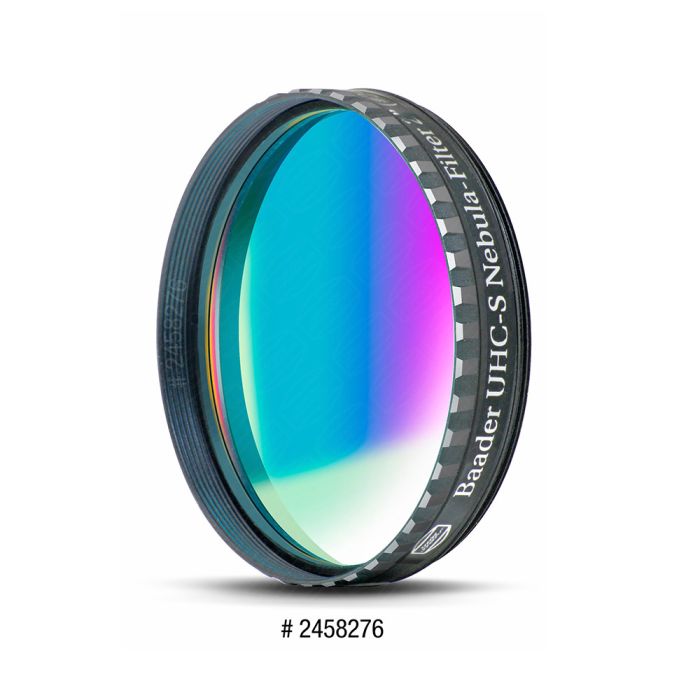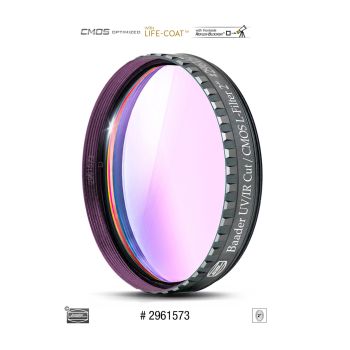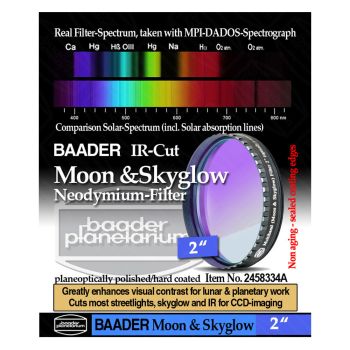Baader UHC-S Nebula Filter - 2" # FUHC-2 2458276

Contiguous US Customers:
All items we sell ship for free within the Contiguous US. Shipping will be via the cheapest shipping method which will vary depending on the items in your order. During checkout, you may also be shown other optional faster shipping choices.
US Customers in Hawaii and Alaska:
Free shipping applies to almost all products. A few large telescopes and mounts are excluded from this free shipping offer. For these items, please contact us to obtain a shipping quote before you check out using the online shopping cart.
International Customers:
Free shipping does not apply to international orders. During check-out, you will be presented with several shipping choices and costs. However, the export of some items may be restricted outside the US due to size or manufacturer restrictions.
Closeout - Item has been discontinued by Baader. All sales final!
Quick Overview
- Baader 1.25” UHC-S filter improves contrast of nebulae for visual observation and imaging
- Wider passband includes OIII (500nm), H-Beta (486nm), and H-alpha (656nm) for brighter views of nebulae, even with smaller telescopes
- Superior fine optical substrates for excellent performance, even at high magnifications
- Hard ion-beam-deposited and scratch-resistant coating for easy, safe cleaning and long life
- Mounted in spring-loaded optical cell to ensure superior optical performance
Product Details
Premium UHC/Light-Pollution Filter for Improving Contrast of Emission Nebulae
The Baader Planetarium 2” UHC-S Nebula filter delivers a high-contrast view of emission nebulae, planetary nebulae, and supernova remnants without excessive dimming and loss of background star fields. The advanced technology coatings an outstanding transmission of over 97% across the entire filter passband that includes emission from OIII, H-Beta, and H-alpha while blocking prominent light pollution lines. It’s ideal for visual observing and imaging in light polluted skies where many nebulae would otherwise be invisible. Even in darker skies, the filter improves the contrast and images of many such objects.
Wider-Bandwidth Operation for Brighter Star Images
The Baader UHC-S manages to improve on the contrast of the typical broadband or so-called "Deep Sky" filters. Sky background is darker, and contrast of emission nebulae are noticeably improved. Most other "UHC" filters tend to excessively darken the sky and star fields, leaving the nebulae looking artificial and flat, set against an empty background. The high transmission, sharp cutoffs, and slightly wider 60nm passband of the Baader UHC-S filter retains a more natural view, yet significantly boosts overall contrast. This is especially important when using smaller telescopes with 4”-10” in aperture where narrower passbands make stars too dim, while owners of larger scopes will enjoy rich star fields and subtle features in many nebulae. Imagers will appreciate the broader passband and the inclusion of an extremely efficient H-Alpha passband (>99% @656nm) that lets through red light from nebulae that’s essential for creating dramatic images of these celestial objects.
Superior Optical Quality, Even at High Magnification
At the heart of the Baader UHC-S filters are their special fine optical substrate polishing process and advanced hard coating design. The result is a filter that imparts virtually no image degradation. Manufacturers of lesser filters, to prevent deterioration from cleaning or exposure to moisture, sometimes resort to sandwiching their delicate coatings between two layers of filter glass, resulting in potential blurred or double images. Unlike these lesser filters, the superior optical quality of the Baader UHC-S filter allows for use at higher magnifications which are particularly useful for studying fine detail, particularly in brighter diffuse and planetary nebulae. Baader UHC-S filters can take high magnifications, and stars retain their pinpoint sharpness, even if the filter is used far ahead of the image plane when used for astrophotography or when used ahead of a star diagonal or binoviewer. Baader filters fulfill the requirements of an ideal optical filter - to perform at highest efficiency without any other detectable effect on the image.
Advanced Optical Manufacturing for Long Life and Superior Performance
Unlike many budget filters, Baader Planetarium filters are not “biscuit cut” out of larger plates of glass, a process that causes micro-cracks around the filter edges. These cracks can attract moisture between the glass substrate and coating layers via capillary action which causes premature aging and degradation.
By contrast, each Baader filter is individually cut to size (1¼", 31mm, 36mm, 2", 50,4mm, 50x50mm, 65x65mm), then polished flat on both sides to a quarter wavelength to ensure maximum image sharpness and distortion over the entire filter, even when the filter is not close to the focal plane. Then each blank is then individually coated with a hard, ion-beam-deposited scratch-resistant coating. However, the coating is not applied all the way to the edge of the substrate to ensure the filter is sealed against the penetration of moisture, even in very humid conditions. This is especially important in multilayer, narrowband filters where moisture can seep in if the coating is not properly deposited. The hard coatings also mean Baader filters are easier and safer to clean without damage.
Baader filters are also tested repeatedly to comply with MIL-specifications. One common process is to boil the test specimen for one hour in salt water to induced damage. Unlike budget filters cut from larger plates, Baader filters remained completely intact without changes in their transmission characteristics after this rigorous environmental testing.
Baader’s careful engineering and manufacturing mean you need to buy a Baader filter just once and it will last you for a lifetime of astronomical observations.
About Baader Filter Cells
Many filter vendors insert their filter blanks into standard tightly-screwed filter cells. Unfortunately, the stress on the filter can result in drastic deformations of the substrate and degradation in optical performance.
That’s why all Baader filters are no longer tightly fixed but are held spring-loaded in the filter cell. The filter glass may ever so slightly “clatter” in the cell when shaken, but that neither affects the image quality nor results in a displacement in the final image. This “clatter” is not a flaw in the filter cell. It is entirely intentional.
Other Information
- Country of Manufacture: Germany








